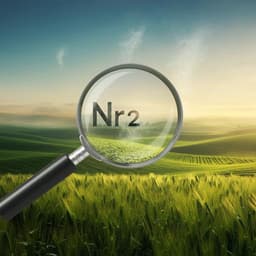
Environmental Studies and Forestry
Managing urban development could halve nitrogen pollution in China
O. Deng, S. Wang, et al.
Halving nitrogen pollution is vital for Sustainable Development Goals, and this groundbreaking research by Ouping Deng, Sitong Wang, and colleagues from China reveals that urban development could significantly reduce nitrogen emissions and water contamination by 2050, yielding substantial economic benefits.
~3 min • Beginner • English
Introduction
The paper addresses the challenge of reducing reactive nitrogen (Nr) pollution arising from multiple sources (croplands, livestock, sewage) and forms (NH3, NOx, N2O, NO3−). Despite advances in abatement technologies, diffuse agricultural emissions remain difficult to control, especially in China where small farm sizes impose socioeconomic barriers to adoption. Urbanization, if unmanaged, can exacerbate pollution and threaten food security, but well-managed urbanization may enable larger farm sizes, crop–livestock integration, and better control of point-source emissions. China, a global hotspot for Nr use and losses, faces severe air and water quality issues linked to Nr, with major health impacts. The study investigates whether well-managed urbanization can halve nitrogen pollution in China by 2050, evaluating changes in population, land use, and agriculture; quantifying Nr reductions across sources and forms; assessing impacts on air and water quality; and conducting a feasibility and cost–benefit analysis.
Literature Review
Background work emphasizes the global call by UNEP and the Convention on Biological Diversity to halve nitrogen waste to meet SDGs. Prior studies document unintended consequences of Nr losses (air/water pollution, soil acidification, biodiversity loss, climate forcing) and highlight barriers in China such as small farm sizes that limit adoption of best management practices. Research indicates that managed urbanization can increase cropland connectivity and farm size, facilitating modern agricultural practices and crop–livestock integration. Policies like China’s Clean Air and Clean Water Acts and efforts toward co-reduction of pollution and carbon provide a context for industrial emissions control. Empirical relationships (e.g., STIRPAT-based inverted U-shape between urbanization and industrial pollutants) and evidence that ammonia abatement is cost-effective for PM2.5 mitigation inform the study’s approach.
Methodology
The analysis covers >2800 counties and proceeds in four stages: (1) simulate urban–rural population shifts and land-use changes; (2) quantify effects on Nr use and losses from cropland, livestock, human, and natural systems; (3) assess impacts on air PM2.5 and nitrogen export to water bodies and oceans; (4) evaluate feasibility and perform cost–benefit analysis.
Data sources: High-resolution land cover (HRRSM-CLC2018, 30 m), DEM, census and statistical data for urban/rural populations, livestock (FAOSTAT, NBSC, APSCC2017), and national emission inventories.
Land-use and urbanization modeling: ArcGIS-based gridded simulations (30 m) of urban expansion and rural land reclamation from 2017–2050, aligning to United Nations World Urbanization Prospects. County urbanization level is defined as the share of urban residents in 2050.
Potential for large-scale farming: Predicts spatial connectivity and extent of potential large-scale cropland by county, assuming 2017 crop structure.
Crop–livestock coupling and relocation: Linear optimization relocates livestock to match county-level manure N supply to cropland demand/carrying capacity (max ~144 kg N ha−1). Prioritizes local relocation to minimize costs; considers provincial capacity and restrictions based on surface water vulnerability. Assumes 60% NH3 reduction in manure management via combined measures; direct NO3 discharge not allowed by 2050.
Nr budget modeling: Uses the CHANS model with 14 subsystems (cropland, livestock, human, industry, forests, grasslands, atmosphere, water, etc.) to establish 2017 baseline and 2050 scenarios reflecting urbanization. Allocates emissions to counties using proxy parameters.
Parameterization of agricultural scaling: Large-scale farming reduces fertilizer use and NH3 emissions using empirical elasticities; recoupling increases manure recycling and NUE. Assumes constant field runoff/leaching efficiency; all manure collected and applied under coupling.
Industrial emissions with urbanization: Uses STIRPAT-derived elasticities for NOx emissions and NO3 discharges under an inverted U-shaped relationship with urbanization.
Air quality modeling: WRF-Chem simulates changes in surface PM2.5 based on updated NH3 and NOx emissions; uses MEIC 2017 and MIX inventories for baseline; computes population-weighted PM2.5.
Hydrology and Nr transport: The Water Network-based Framework (WNF) simulates Nr routing, retention, and export to oceans, driven by changes in Nr losses to surface runoff from all sources.
Cost–benefit analysis: Implementation costs include agricultural optimization (rural homestead reclamation, cropland consolidation, livestock relocation), industrial upgrading (GAINS cost modules), and wastewater/garbage construction and operations (project datasets, PPP platform). Benefits include human health (PM2.5-related), ecosystem services (reduced eutrophication and terrestrial impacts), climate (N2O and carbon sequestration effects), and economic gains (fertilizer savings and yield increase from added cropland). Unit damage costs and valuation use established literature with PPP/WTP adjustments.
Key Findings
- Total national Nr losses decline from 33.8 to 18.3 Tg N yr−1 (−46%) under well-managed urbanization, with reductions of 10.9 Tg in agriculture, 3.4 Tg in human, and 1.2 Tg in natural systems.
- Atmospheric emissions:
• NH3: 11.9 → 6.7 Tg N (−5.2 Tg, −44%); cropland −2.8 Tg, livestock −1.8 Tg; driven by higher NUE (cropland NUE 43% → 59%), reduced fertilizer use (28.9 → 12.9 Tg N with recoupling), and increased manure recycling (Nr recycling ratio 23% → 63%).
• NOx: 4.8 → 3.4 Tg N (−1.4 Tg, −30%); reductions mainly from the human/energy system due to efficiency and cleaner energy; small increase from waste incineration (+0.1 Tg) but minor share overall.
• N2O: −0.47 Tg N (−33%) relative reduction; largest cuts from agriculture (−0.36 Tg) via lower N inputs; indirect N2O also reduced (−0.11 Tg) by lower downstream/upwind N.
- Water pathways:
• Nr runoff and leaching (reported as NO3−): 15.6 → 7.3 Tg N (−8.3 Tg, −53%); largest cuts from livestock (−3.2 Tg) and cropland (−2.7 Tg); wastewater treatment plant loads increase by ~0.5 Tg but direct wastewater discharge and garbage leaching decrease by ~2.1 Tg.
• Export to ocean: 6.8 → 3.5 Tg N (−49%), especially benefiting the Bohai Sea region.
- Air quality and health:
• National mean PM2.5: 28.0 → 25.6 µg m−3 (−2.4 µg m−3, −9%); maximum local reduction ~−7.7 µg m−3 in the North China Plain.
• Population-weighted PM2.5: 41.4 → 32.8 µg m−3 (−8.7 µg m−3, −21%); population above 35 µg m−3 declines from 609 to 476 million (−22%).
- Spatial patterns: >96% of counties reduce Nr losses; a few mega-city counties may increase due to concentration of point sources; North China Plain and Sichuan Basin show major reductions via larger farms, livestock relocation, and improved sewage treatment.
- Economic assessment:
• Annualized implementation cost ≈ US$ 61 billion yr−1 by 2050: agricultural optimization ~US$ 43B; industrial upgrading ~US$ 11B; wastewater/garbage ~US$ 8B (incl. ~US$ 3B annualized capital and ~US$ 4B O&M).
• Benefits ≈ US$ 245 billion yr−1: ecosystem ~US$ 156B; human health ~US$ 75B; fertilizer savings + yield gains ~US$ 24B; net climate −US$ 9B (N2O benefits ~US$ 6B offset by reduced C sequestration ~−US$ 15B). Benefit-to-cost ratio ~5:1.
- Additional: Environmentally benign N2 denitrification emissions decline by ~10% (−2.3 Tg N), signaling more efficient N cycling and reduced waste.
Discussion
The findings demonstrate that well-managed urbanization can deliver synergistic reductions in multiple Nr forms across sectors, thereby addressing the core challenge of diffuse agricultural and rural non-point source pollution. Migration from rural to urban areas concentrates point sources where treatment and regulation are more effective, while enabling land consolidation and professionalized, large-scale farming. Recoupling crop and livestock systems improves manure recycling, raises NUE, and lowers fertilizer needs, collectively reducing NH3, N2O, and NO3− losses. Industrial and household energy upgrading further decreases NOx. These combined effects translate into significant improvements in air quality (lower PM2.5 exposure) and water quality (reduced riverine and marine N loads), with substantial societal benefits outweighing costs by roughly fivefold. Spatial analysis highlights priority regions (North China Plain, Middle–Lower Yangtze, Sichuan Basin) for maximal gains, while noting that a few mega-cities may see localized increases, underscoring the need for stringent urban treatment capacity and emission controls. The results support integration of nitrogen management with urban planning and environmental policies to advance multiple SDGs.
Conclusion
This study shows that, by 2050, well-managed urbanization in China could nearly halve reactive nitrogen pollution across air and water pathways, while yielding large net societal benefits. Key elements include rural land reclamation and cropland consolidation to enable large-scale farming, crop–livestock recoupling with enhanced manure recycling, and strengthened urban point-source controls and industrial upgrades. These measures collectively reduce NH3, NOx, N2O emissions and NO3− runoff/leaching, improve PM2.5 exposure metrics, and cut nitrogen export to the oceans. Policy priorities include accelerating land system reforms, supporting livestock relocation and integration with cropland, expanding urban wastewater and waste treatment capacity, and aligning nitrogen mitigation with co-control of air pollutants and carbon (NetZero). Future research should extend to social and economic dimensions of urbanization, including diet and production structure changes, and continue improving national-scale water quality model validation and nitrogen flow tracking.
Limitations
The analysis focuses on biophysical aspects of well-managed urbanization and does not model social and economic changes such as diet shifts. Dietary transitions (e.g., increased meat or aquatic product consumption) could alter livestock production, feed demand, and nitrogen use, affecting Nr losses in complex ways. Health benefits are quantified primarily through PM2.5 exposure; toxic effects specific to NOx and other pollutants are not separately modeled due to methodological constraints. Water quality modeling at national scale is limited by sparse time-series observations; while estimates align reasonably with several models (e.g., IMAGE-GNM, DNDC, MARINA), uncertainty remains, particularly for Nr export to oceans. Denitrification to N2 is uncertain but included for mass balance. Assumptions include constant field runoff/leaching efficiency, full manure collection and application under coupling, and strict prohibition of direct NO3 discharges by 2050, which may affect the magnitude of estimated reductions.
Related Publications
Explore these studies to deepen your understanding of the subject.







